A small label on clothing not only provides clothing information, but is also an important part of enhancing the brand image. An exquisite label can leave an indelible impression on consumers. So, how to create labels for clothing? Please read this article in detail. We will introduce the creation process of clothing labels, from material selection to the creation process, to provide you with comprehensive guidance.

What should be considered before creating labels for clothing?
Consider the choice of materials
When choosing clothing label materials, you should consider both their visual appeal and their realistic application. Each material has its own unique charm, and you can choose the right material according to the actual situation. The materials commonly used for labels are usually the following:
- Satin: It is highly praised for its expensive luster and exquisite appearance, adding a luxurious and noble atmosphere to clothing.
- Cotton: It is highly praised for its natural softness and breathability, especially suitable for more close-fitting clothing.
- Organic cotton: It is an environmentally friendly material, so it is very popular with the public.
- Polyester fiber: It is elastic and fade-resistant, and it is a versatile material that can meet the needs of all kinds of clothing.
- Nylon: It has high wear resistance, lightness and water resistance, so it also has a unique charm.

Determine the appropriate printing or production method
Each printing method has its own advantages and disadvantages, and different label styles require different printing methods.
- Digital printing: fast speed, high flexibility, suitable for small batch label customization; but the cost is high, and the cost of mass production is not as low as traditional printing.
- Screen printing: can provide bright and durable colors; but the process is complicated, the cost is high, and it is not suitable for printing delicate patterns.
- Thermal transfer: suitable for labels that require soft touch and flexibility; but the pattern has poor durability and is easy to fade after multiple washings.
- Woven labels: can weave delicate patterns and exude a noble and luxurious atmosphere; but the production cycle is longer.

How to create labels for clothing?
After the preliminary preparations are completed, you can enter the label creation process.
Step 1:Design the label
Choose the design software
When designing the label, it is crucial to choose the right software. You can choose Adobe Illustrator or Adobe Photoshop, as they are professional design software that can achieve precise design.
Output the designed label
Start designing your logo and text content. This step is the core of the whole process. The overall design of the label should be concise and consistent with the overall image of the garment.

Step 2:Print the label
Choose the printing method
Printing the label correctly is crucial to ensure the final label effect. Choose between iron-on transfer paper and printable fabric sheets. Each has unique advantages, so choose the method that suits you best.
Prepare to print
Fix your garment on freezer paper to ensure that the garment remains flat and stable during the printing process, and then use an inkjet printer to print your designed label for bright colors and clear details.

Step 3:Stick the label
Ironing the label
You can choose to iron the label. Place the label where you want to stick it, cover it with a piece of cotton cloth or towel, set the iron between 160℃-180℃, and move the iron back and forth when ironing to make the heat even. This step activates the adhesive on the transfer paper so that the label can be firmly attached to the clothes.
Sewing the label
You can also choose a more traditional method and sew the label, which is both durable and classic. First, position the label precisely on the clothing, making sure it is perfectly aligned with the position you want. After positioning, carefully sew the edges of the label with needle and thread. This method not only holds the label firmly in place, but also adds handmade charm to your work.
Whether you choose the convenience of ironing or prefer the traditional art of sewing, each method contributes to the uniqueness of the label.

Summary:
Through this article, do you know how to create labels for clothing? As long as you master the above steps, you can easily design and apply your unique clothing labels, and ultimately improve consumer satisfaction.




